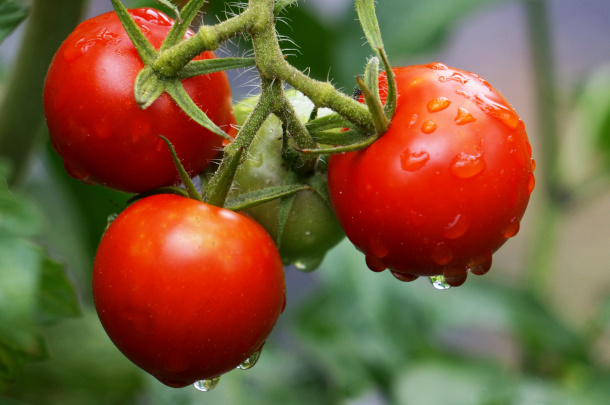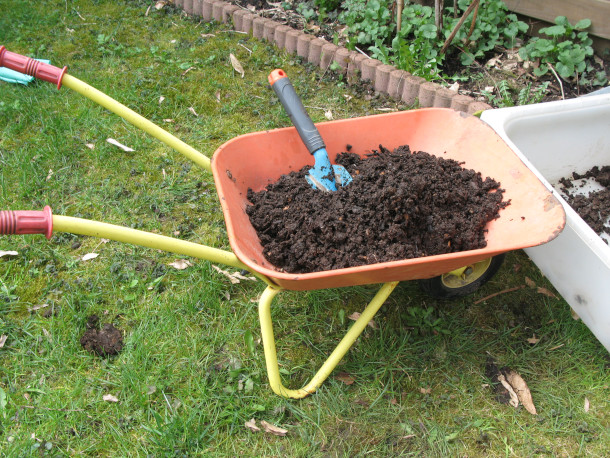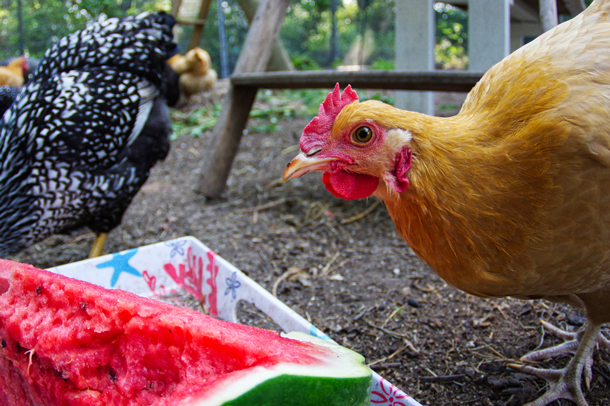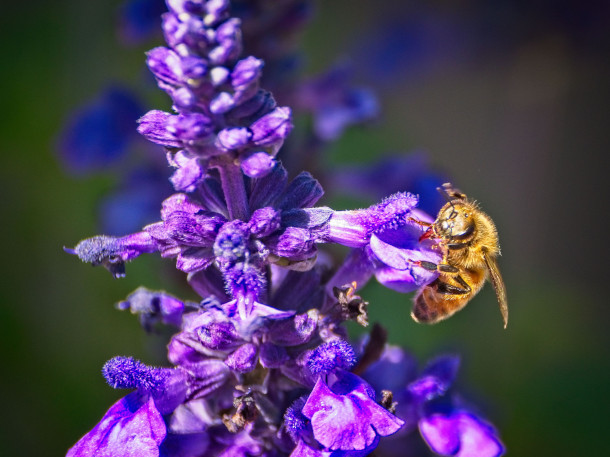Gardening on a Budget
Air Date: Week of June 3, 2022

Tomatoes are known for adding flavor to any dish and for being the vegetable that keeps on giving. They grow best in fertile soil and good sunny sheltered spots. (Photo: j_arlecchicno, Flickr, CC BY NC 2.0)
With inflation driving up prices of many products including food, a great way to access quality produce without breaking the bank is to grow it yourself. Michael Weishan, former host of the Victory Garden on PBS, spoke with Living on Earth’s resident gardener Bobby Bascomb.
Transcript
CURWOOD: Inflation is now driving up prices for many products including food. Healthy organic food already came with a premium, so growing it yourself can be a way to access quality produce at affordable prices. Some up-front investment is required, but our gardening guru Michael Weishan has tips on how to save some green with your green thumb. Michael is also the former host of the Victory Garden on PBS and spoke with Living on Earth’s resident gardener Bobby Bascomb.
WEISHAN: I am delighted to be back.
BASCOMB: What are you thinking about this year as you're starting to plant your garden and trying to be frugal about it?
WEISHAN: You know, the costs are going up everywhere. I mean, it's not only in food but it's in gasoline and oil especially in electricity. And you've got to remember that gardening is very energy intensive, you would think it's not because you would think it's green, right? I mean, you know, we're out there in the garden in the sun in the soil. But the reality is it's highly petroleum based. I mean, the fact of the matter is all the plants that you buy are started in greenhouses that are heated generally by gas or electricity. They're put in plastic pots, which are made from petroleum, they're then shipped to your nursery which uses petroleum. They're then heated there which uses you know, energy, and it goes on and on right, even down to the fertilizer you apply in your garden. So, you know, one of the best ways to talk about saving money in the garden and also saving the environment is growing your own seeds. I have been very active this spring both in growing vegetable starters, which have skyrocket in price. I don't know if you've seen them at the nursery, but it's just, you know, you're talking $2.99, $3.99 a pack of four little vegetables. And if you think about it, that's four seeds. And a pack of seeds is two bucks, so you can do the math.
BASCOMB: Now, what about soil, you know, a good bag of gardening soil is going to run you around 10 bucks or so and you're going to need a lot of them depending on how big you want to make a garden if you're starting a new garden this year. That is, do you have any tips on how to come by some more affordable soil for a garden?
WEISHAN: Compost, compost piles is your best friend. Soil has gotten crazy bonkers expensive, obviously, because it's heavy and it requires a lot of transport, which is of course is expensive. In this particular case, the easiest way to get around this is to have your own compost pile. And there's a trick to compost and it's easy but it's not. And if you don't follow the trick, the whole thing fails. And here's the trick.

Lettuce is a wonderful vegetable to incorporate into your garden because it regrows once its leaves have been cut or picked off the main stem. (Photo: Dwight Sipler, Flickr, CC BY 2.0)
BASCOMB: Okay.
WEISHAN: It needs to be turned, which means you need to take the bottom of the pile to the top and the top of the pile to the bottom. If you just let it sit of its own volition it's going to take years and years to fully rot down to the point where you can really use it. If you turn it, it's ready in three to four months. So, and you think why would you want to do that it like sounds like a lot of work. But you get this incredible content of soil, which then you can do anything with, you can add grit to, to make cactus mix, you can add vermiculite or perlite to make a perfect potting mix for any type of indoor plant. You can put it directly onto your garden, you can use it as mulch, which is what the English do, they don't do our whole bark business. And you know, I have ducks and geese here so we put the bedding in the shavings and the and the debris. And it makes incredible soil very quickly, but you have to turn it. And I must admit I don't turn in any more myself. I hire a kid. I hire two kids from high school, it takes them about two hours, they go out there with pitchforks, they go, boom, boom, boom, boom, and it's done. Otherwise, I'd be going one, two. [LAUGH] You know, as you're getting older you have to be realistic about some of these efforts you can make.
BASCOMB: The cost savings might be, you know, offset by the Advil you have to be taking the next day after something like that.
WEISHAN: Yeah, although I will say in terms of like incredible potting soil for inside for the greenhouse, you couldn't buy it.
BASCOMB: Yeah, you know, another thing I've been thinking about, just in terms of compost and augmenting your soil is, you know, I live near a ton of horse farms and goat farms and all sorts of things like that. I mean, I wonder, have you ever approached some farming neighbors and said, hey, you know what or maybe hire those high school kids to, you know, take away some manure and improve the soil that way? I mean, I bet that'd be an option for some people.

Compost after sifting, which aerates the compost, improving the soil structure of your garden beds. Compost can be made in as little as 6 to 8 weeks. (Photo: Susana Secretariat, Flickr, CC BY 2.0)
WEISHAN: Oh, yeah, absolutely. I kept horses here for a long time so I had my own manure sources. But you can go look to your local bridle stable, for instance, and they have a ton of manure that they're just always praying to get away. So you can, if you go have a pickup or a friend who does or some means of conveyance. Sometimes they'll even deliver a load to you because they just really want to get rid of it. Then you put it in a big pile and then you spread it out in the garden. Now, cow manure is the best because it doesn't have seeds, weed seeds in it, horse manure, their digestive process isn't as good so it still has weed seeds. And frankly, I don't care because the incredible benefit it gives to the soil is phenomenal. One thing I will say just be real careful with chicken manure, which is also a very good fertilizer, but that is the one that cannot be applied directly to the garden. It's too hot. It needs to go onto a dormant garden. It can go over winter, or into the compost pile, but not ever directly applied and dug in like you can with horse manure or cow manure.
BASCOMB: Well you know, speaking of chickens, you and I both have chickens, we have a flock of about six here. And I think they're great, you know, we feed them our kitchen scraps and maybe some store about food and they give us eggs and fertilizer. What's not to love about chickens?
I don't know and frankly, if you've seen the price of a dozen eggs recently, you'll really appreciate these little girls and all the work that they do on your behalf. [QUAKING] As a matter of fact, you may be hearing one of my chickens or ducks out there. Even as as we're speaking. I really would urge everyone to go into the chicken biz, even if it's a couple of hens. They are wonderful things to have around the garden, they eat every single bit of debris, they eat every bug, you could possibly ticks, roaches, spiders. I mean, you name it, if it moves, they eat it. They also eat all your kitchen scraps, which is one of the reasons I sometimes my compost is a little slow, because I don't have any kitchen scraps to put out in the compost pile. Because the chickens eat it all. And they refine it into these fantastic eggs, which you know, you know, if you have your own eggs, they're not anything like store bought eggs. They have a much more golden colored yolk, they whip up easily, you can make egg whites practically by hand. And they're just fantastic for every possible of possible use.

If you have the space, chickens can be a great addition to your garden. They are known to enjoy eating berries, mealworms, and watermelon. (Photo: Art by Heather, Flickr, CC BY-NC-ND 2.0)
BASCOMB: So true. Now, what do you think might be, you know, for somebody that's listening to us and has a little bit of spare cash wants to start something. What's the the easiest thing to get started with and maybe the most cost effective? What's the best bang for your buck? You know, one zucchini plants gonna give us zucchini for the rest of the summer, maybe the rest of your life. But what do you think he meant in that sense?
WEISHAN: You know, a while back, there was a book and I'm paraphrasing the title was my sixty-dollar tomato?
BASCOMB: Sixty-four dollar tomato, yeah. [LAUGH]
WEISHAN: Sixty-four dollar tomato, there you go. If you look at the cost of starting a garden, it's high. Because you have to clear the soil, you have to dig it or have it dug for you. You then have to buy the plants or start the seeds. So you're looking at a multi-hundred dollar investment easily. And then you know people buy the tomato cages and the fertilizer and the little labels and the little fencing that goes around it. So by the time you're all said and done you in the big box stores are are married to about 200 bucks, at least. One of the greatest ways to start if you just want to start to try to do something is to grow greens in pots. I'm growing a whole crop of Bibb, various types of Bibb and small head lettuces, one called tennis ball in a trough outside my back door. And these cut and come again lettuces, they're fantastic. You can make salads off them, and you can cut them and eat them and cut them and eat them and cut them and eat them. The way to make a garden cost effective is very simple. Keep gardening, because the startup costs are what they are, they're fixed. So if you try it and then stop, I mean, essentially you do have the sixty-four dollar tomato. But if these costs are amortized over five years, 10 years, 15 years, then you have the fifteen cent tomato. And the pleasure of having produce that you've grown yourself and the sense of satisfaction and the fact that you can't buy a lot of this produce because it's not shippable it's so damageable, it's so tender often that these varieties don't ship, so you have these incredible meals. I mean, there's a thousand good things about it. But again, it goes back to you know what we've been talking about all the way along, which is this sort of realistic self awareness of gardeners. What are you actually going to do? How much time do you have to do it? How much space do you have to do it in? And do you have the right site to do it in? So, again, being realistic about what you have and what you can potentially produce will be a much more cost effective proposition.

Salvia is in the family of perennials, plants that live more than two years. Salvia is a drought tolerant plant and pollinators such as honeybees love them. (Photo: Jim & Robin, Flickr, CC BY NC 2.0)
BASCOMB: Well, Michael, I really appreciate your time today. You've given us lots of ideas here to avoid that sixty four dollar tomato. So thank you, and maybe we'll talk with you again later this summer.
WEISHAN: Oh, that would be great. Maybe we can do a year end review and see what worked and what didn't and whether I succeeded in not growing the sixty four dollar tomato.
BASCOMB: Oh, you're a pro. I'm sure you won’t.
WEISHAN: Oh, you never know. It's easier to fail than to succeed sometimes. So I just I just will keep my prayers to the garden gods that all goes well.
BASCOMB: That’s Living on Earth’s Bobby Bascomb speaking with our gardening guru and former host of the Victory Gardens on PBS Michael Weishan.
Links
Living on Earth wants to hear from you!
Living on Earth
62 Calef Highway, Suite 212
Lee, NH 03861
Telephone: 617-287-4121
E-mail: comments@loe.org
Newsletter [Click here]
Donate to Living on Earth!
Living on Earth is an independent media program and relies entirely on contributions from listeners and institutions supporting public service. Please donate now to preserve an independent environmental voice.
NewsletterLiving on Earth offers a weekly delivery of the show's rundown to your mailbox. Sign up for our newsletter today!
 Sailors For The Sea: Be the change you want to sea.
Sailors For The Sea: Be the change you want to sea.
 The Grantham Foundation for the Protection of the Environment: Committed to protecting and improving the health of the global environment.
The Grantham Foundation for the Protection of the Environment: Committed to protecting and improving the health of the global environment.
 Contribute to Living on Earth and receive, as our gift to you, an archival print of one of Mark Seth Lender's extraordinary wildlife photographs. Follow the link to see Mark's current collection of photographs.
Contribute to Living on Earth and receive, as our gift to you, an archival print of one of Mark Seth Lender's extraordinary wildlife photographs. Follow the link to see Mark's current collection of photographs.
 Buy a signed copy of Mark Seth Lender's book Smeagull the Seagull & support Living on Earth
Buy a signed copy of Mark Seth Lender's book Smeagull the Seagull & support Living on Earth

